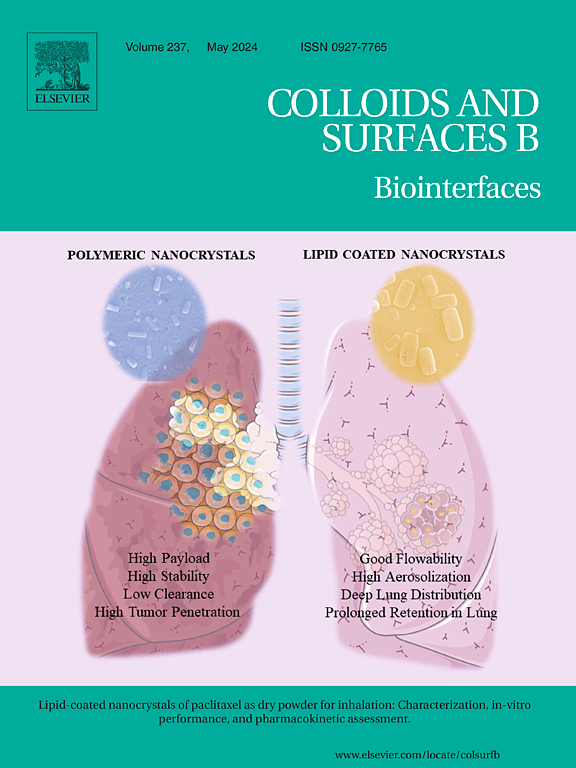光催化、光热和可透过血脑屏障的碳纳米点:β淀粉样蛋白斑块的强效多功能清除剂。
IF 5.6
2区 医学
Q1 BIOPHYSICS
引用次数: 0
摘要
阿尔茨海默病(AD)与大脑中淀粉样蛋白的产生和堆积有关,从而导致神经变性。在这项研究中,我们利用溶剂热技术制备了光敏碳纳米点(L-CNDs)。L-CNDs 具有出色的光催化特性,在 630 纳米波长的照射下可产生单线态氧(1O2)。在 808 纳米波长的照射下,L-CNDs 的光热转换效率高达 68.25%,可实现局部加热并调节 Aβ 的聚集。L-CNDs 通过疏水作用和 π-π 堆积结合 Aβ。在光热疗法(PTT)、光动力疗法(PDT)和 PTT/PDT 协同疗法中,10 μg-mL-1 的 L-CNDs 抑制 Aβ 聚集的效率分别为 61.08%、75.09% 和 91.72%。L-CNDs 能有效抑制 Aβ 的错误折叠、抑制纤维化并促进成熟纤维的分解。L-CNDs 可减轻 Aβ 在 PC12 和 HT22 细胞中诱导的细胞毒性。有趣的是,数据显示 84.6% 的 L-CNDs 可在处理 8 小时后穿透 bEnd.3 细胞,这表明它们因体积小而具有穿过血脑屏障(BBB)的能力。体外研究表明,L-CNDs 可以穿过血脑屏障。总之,我们的研究结果揭示了一种利用碳纳米点治疗淀粉样蛋白疾病的独特技术,该技术在该领域的未来研究中具有巨大潜力。本文章由计算机程序翻译,如有差异,请以英文原文为准。
Photocatalytic, photothermal, and blood-brain barrier-permeable carbon nanodots: A potent multifunctional scavenger for β-amyloid plaque
Alzheimer’s disease (AD) is associated with amyloid production and buildup in the brain, leading to neurodegeneration. In this study, we used a solvent-thermal technique to produce light-sensitive carbon nanodots (L-CNDs). L-CNDs exhibit outstanding photocatalytic properties, producing singlet oxygen (1O2) under 630 nm irradiation. L-CNDs have a high photothermal conversion efficiency of 68.25 % under 808 nm irradiation, allowing for localized heating and regulation of Aβ aggregation. L-CNDs bind Aβ through hydrophobic interaction and π-π stacking. L-CNDs inhibit Aβ aggregation with efficiencies of 61.08 %, 75.09 %, and 91.72 % at 10 μg·mL−1 in photothermal therapy (PTT), photodynamic therapy (PDT), and PTT/PDT synergistic therapy, respectively. L-CNDs efficiently suppress Aβ misfolding, inhibit fibrillation, and promote disaggregation of mature fibrils. L-CNDs mitigate Aβ-induced cytotoxicity in PC12 and HT22 cells. Interestingly, the data showed that 84.6 % of the L-CNDs could penetrate bEnd.3 cells after 8 h of treatment, demonstrating that they have the capacity to cross the blood-brain barrier (BBB) because of their small size. In vitro investigations have shown that L-CNDs can pass through the BBB. Collectively, our findings reveal a unique technique for treating amyloid disorders using carbon nanodots with significant potential for future studies in this area.
求助全文
通过发布文献求助,成功后即可免费获取论文全文。
去求助
来源期刊

Colloids and Surfaces B: Biointerfaces
生物-材料科学:生物材料
CiteScore
11.10
自引率
3.40%
发文量
730
审稿时长
42 days
期刊介绍:
Colloids and Surfaces B: Biointerfaces is an international journal devoted to fundamental and applied research on colloid and interfacial phenomena in relation to systems of biological origin, having particular relevance to the medical, pharmaceutical, biotechnological, food and cosmetic fields.
Submissions that: (1) deal solely with biological phenomena and do not describe the physico-chemical or colloid-chemical background and/or mechanism of the phenomena, and (2) deal solely with colloid/interfacial phenomena and do not have appropriate biological content or relevance, are outside the scope of the journal and will not be considered for publication.
The journal publishes regular research papers, reviews, short communications and invited perspective articles, called BioInterface Perspectives. The BioInterface Perspective provide researchers the opportunity to review their own work, as well as provide insight into the work of others that inspired and influenced the author. Regular articles should have a maximum total length of 6,000 words. In addition, a (combined) maximum of 8 normal-sized figures and/or tables is allowed (so for instance 3 tables and 5 figures). For multiple-panel figures each set of two panels equates to one figure. Short communications should not exceed half of the above. It is required to give on the article cover page a short statistical summary of the article listing the total number of words and tables/figures.
 求助内容:
求助内容: 应助结果提醒方式:
应助结果提醒方式:


